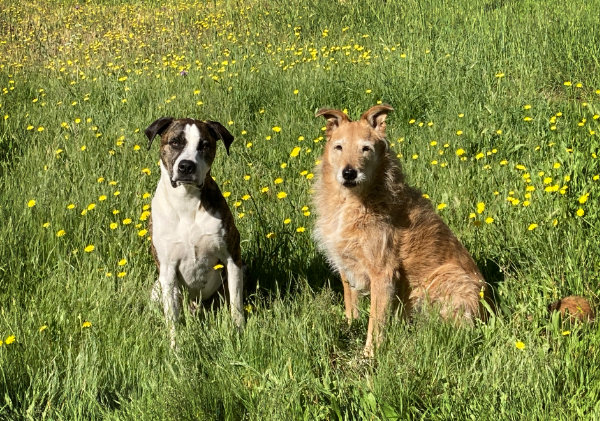“Teenage” Dogs Can Be Difficult
Dog trainers are most likely to hear from new prospective clients when the clients’ dogs are in the throes of adolescence – and it’s easy to see why. Puppies are adorable, fun, and easy! They get tired quickly and even if they are not taking well to a forced nap in a safely confined area, their unhappy reaction never lasts long. Many puppies are so darn cute and easy to manage, that they never receive formal training beyond the very common “Sit! Sit! SIT!” (and push the puppy’s bottom to the floor)-style of training that people who don’t know better invariably put their puppies through.
Then those sweet, tractable puppies enter adolescence. They don’t get tired so easily. They learn to be more persistent about airing their grievances when confined or restrained. They develop “object permanence,” whereby they totally remember where you put that thing that you took away from them, and they work to get it back, instead of forgetting it exists, like they might have when they were toddlers. They develop opinions and interests: “Oh my dog, I LOVE squirrels! I want to go see that squirrel RIGHT NOW! Squirrels are the BEST!” They need more physical exercise and more mental stimulation and more information about what they ought to be doing with their time; lacking these things, they become inventive about entertaining themselves.
And their owners tend to freak out at these developments – as if they weren’t natural and normal!
At this point, unprepared and irresponsible (or just wildly overwhelmed) owners tend to bring those pups to a shelter, or try to rehome them on Craigslist. More responsible owners will call a trainer – although they might freak out even more when they find out that the “teen dog” training classes have been booked months in advance.
Before I went on a several-year jag of fostering large litters of puppies for my local shelter, I used to foster adolescent dogs for them. My husband and I sold the house where I used to have my office – and where I used to foster all those puppies – and our new house is nowhere near as well set up for fostering puppies; there isn’t a good place (yet) for setting up a safe, foxtail-free play yard or a place where moms and tiny puppies can be comfortable in all weather (cool in our brutally hot summers, warm in our coldish winters). So it looks like I’m back to taking on adolescent foster dogs, rather than raising puppies.
The dog I was calling Kiki was my last foster. She was the typical adolescent shelter owner-surrender: relentlessly active, curious, and smart. She had picked up a few good-manners behaviors while staying in her second adoptive home, but was too pesty to get along with the adult dog there, and got returned again. Besides the things she learned in that home, she didn’t know much; she clearly hadn’t been taught anything by the people in her first home. So, while she spent a good part of any free time she had picking up items that belong to humans and putting them in other places – such as, taking the gardening gloves off the table on the back deck, and placing one next to the fence at the back of our two acres and the other next to my car in the carport – and driving my dog Woody to near-depression with her unending pestering, she was also quite interested in working with people and learned things very quickly. Within weeks, I could take the funny little mixed-breed dog with gigantic ears on off-leash hikes and mountain bike rides, for rides in the car (she rode and waited in the car with impeccable calm), and to friends’ homes. This took a lot of work and attention, however. If we failed to get out for a fair bit of exercise each day, she’d start looking for things to occupy her time – not good things, either. She was a classic “teenager” – but I’m confident she’s going to be a terrific adult.
Kiki got placed in a terrific home about 8 weeks ago – and then, just two weeks later, we had a death in the family (my brother-in-law). The disruption in my schedule and tasks that I’ve taken on to help my sister have been taking up all my spare time, and I haven’t yet contacted the shelter to see if there is another dog that needs foster care and training. So it’s been about 8 weeks with only my two adult dogs here, and I have to say . . . it’s heaven. They are such an easy pleasure to be around.

Folks, it might take a year or two, but I assure you: If you stick with them, keep up the training and the exercise and the good, solid management, your crazy, impulsive, naughty adolescent dog is going to mature into the best dog ever, and the memory of those endless days of finding holes in the lawn and chewed-up shoes and gloves all over the property will fade, I promise. If I read the articles I wrote about my 13 ½-year-old dog Otto when he was an adolescent, why, I would barely recognize the issues we were dealing with then. And the worrisome behaviors that 5 ½-year-old Woody exhibited during his adolescence (namely, he went through a period of about a year where the well-socialized, formerly friendly, confident puppy turned into a fearful, growly adolescent when meeting strangers), have completely disappeared. As he matured, with a lot of counter-conditioning and desensitization, he outgrew those fears and regained his former happy, goofy confidence.
Personally, I think every puppy should come with a disclaimer: “There is likely to be a period, about six to eight months from now and lasting as long as a year or more, when you will seriously consider giving this puppy away. Please get ready and do your homework now, even when it seems completely unnecessary because this is such a good little puppy, and you will get through the puppy’s “teenage phase” with your relationship, family, and home intact.”

For more information, see these articles on teen dogs (note that the titles of the articles may be different in the print version of the magazine and the online version):
“Teen Angel,” November 2014
“Social Studies,” October 2015
“The Puppy Raising Challenge,” November 2017
“Smells Like Teen Spirit,” March 2018
“Time Flies When You Get a Puppy,” March 2017
“Fear Not!” December 2018
Did you have problems with your dog when she or he was an adolescent? How did you get through that period?





